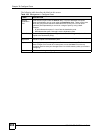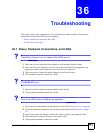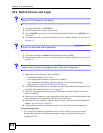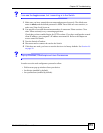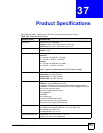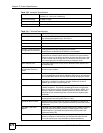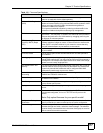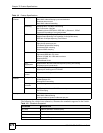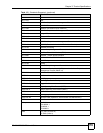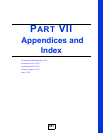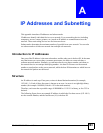
Chapter 37 Product Specifications
GS-3012/GS-3012F User’s Guide
276
Storage Environment Temperature: -25º C ~ 70º C (-13º F ~ 158º F)
Humidity: 10 ~ 90% (non-condensing)
Ground Wire Gauge 18 AWG or larger
Power Wire Gauge 18 AWG or larger
Fuse Specification 250 VAC, T2A
Table 110 Firmware Specifications
FEATURE DESCRIPTION
Default IP Address In band: 192.168.1.1
Out of band (Management port): 192.168.0.1
Default Subnet Mask 255.255.255.0 (24 bits)
Administrator User Name admin
Default Password 1234
Number of Login Accounts
Configurable on the Switch
4 management accounts configured on the Switch.
Authentication via RADIUS and TACACS+ also available.
VLAN A VLAN (Virtual Local Area Network) allows a physical network to be
partitioned into multiple logical networks. Devices on a logical network
belong to one group. A device can belong to more than one group. With
VLAN, a device cannot directly talk to or hear from devices that are not
in the same group(s); the traffic must first go through a router.
MAC Address Filter Filter traffic based on the source and/or destination MAC address and
VLAN group (ID).
DHCP (Dynamic Host
Configuration Protocol)
Relay
Use this feature to have the Switch forward DHCP requests to DHCP
servers on your network.
IGMP Snooping The Switch supports IGMP snooping, enabling group multicast traffic to
be only forwarded to ports that are members of that group; thus allowing
you to significantly reduce multicast traffic passing through your Switch.
Classifier and Policy You can create a policy to define actions to be performed on a traffic flow
grouped by a classifier according to specific criteria such as the IP
address, port number or protocol type, etc.
Queuing Queuing is used to help solve performance degradation when there is
network congestion. The following scheduling services are supported:
Strict Priority Queuing (SPQ) and Weighted Round Robin (WRR). This
allows the Switch to maintain separate queues for packets from each
individual source or flow and prevent a source from monopolizing the
bandwidth.
Bandwidth Control Bandwidth control means defining a maximum allowable bandwidth for
incoming and/or out-going traffic flows on a port.
Broadcast Storm Control Broadcast storm control limits the number of broadcast, multicast and
destination lookup failure (DLF) packets the Switch receives per second
on the ports.
Two Rate Three Color
Marker
Two Rate Three Color Marker (trTCM, defined in RFC 2698) is a type of
traffic policing that identifies packets by comparing them to two user-
defined rates: the Committed Information Rate (CIR) and the Peak
Information Rate (PIR).
Port Mirroring Port mirroring allows you to copy traffic going from one or all ports to
another or all ports in order that you can examine the traffic from the
mirror port (the port you copy the traffic to) without interference.
Table 109 Hardware Specifications



